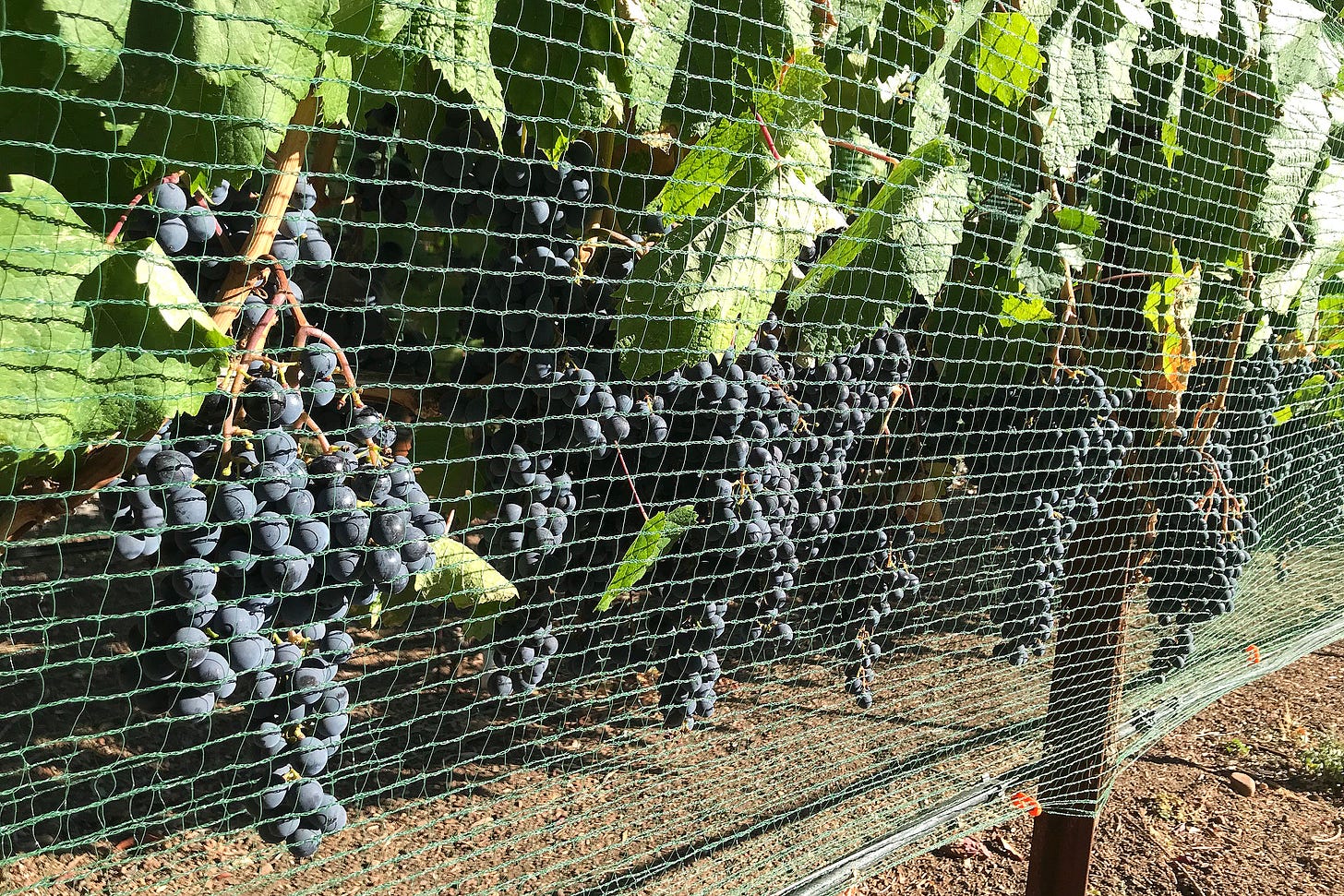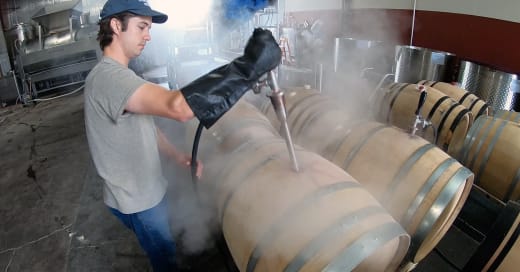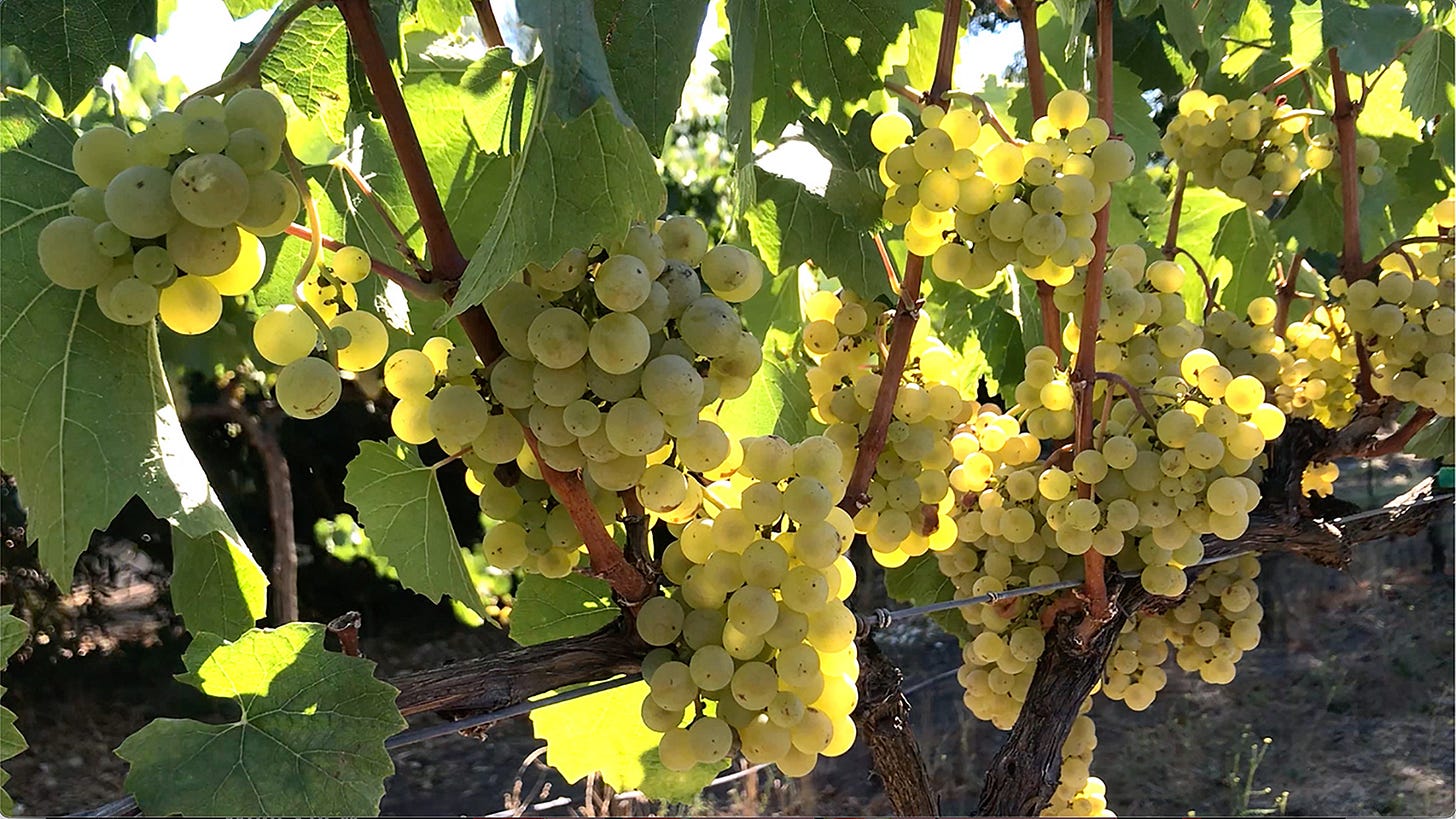We should all do what, in the long run, gives us joy, even if it is only picking grapes or sorting the laundry. - E. B. White
Hotter'n a stolen tamale
Jumpin’ Jehosaphat, is it ever toasty out there! Normally, when we get a heatwave this time of year it turbo charges grape ripening and the harvest comes in early. But when it gets into the mid- to high 90°s for any extended period of time the vines just shut down along with any ripening. That’s what’s happening now. It was 106° yesterday, and it’s forecasted for 110° today!
I asked my grape guru buddy Ken Wornick of Dysfunctional Family Winery if he was accelerating any of his harvests to try and get some grapes in before the worst of it, or if he was going to ride it out. His response was to “Definitely irrigate and ride. No panic. Let that fruit ripen down the road. It will take a beating and it will recover.”
It’s good to have a guru.
We’re picking over 11 tons of grapes this year but so far only two of those picks are getting close, our Valley Merlot and a new Mountaintop Cabernet Sauvignon we tested last year. They were at 23° and 23.5° Brix respectively a few days ago, but we’re going to ride it out on both of them.
Liquid Gold
What did come in ahead of the heat with perfect chemistry and physiological cues, not to mention delicious taste, was the Chardonnay we had planned to pick from the small private Harf Vineyard in east Sonoma. Doing a grape sampling there a week ago Wednesday I got 23.5°Brix and a pH of 3.22, which was sweet enough to start attracting the birds—and the bees—and it was clear to all of us that if we didn’t harvest by that weekend there might not be too many grapes left.
Once we committed to Chardonnay as one of our 2022 vintage varietals it was a bit of a mad rush to get prepared. I dove into deep research as to what kind of Chardonnay I wanted to make, what type of yeast to use, and how we were going to process the grapes. There was no question that the crisp, lower alcohol, higher acidity, natural wine expression of the grape was intriguing, and that seemed to be the way all the young winemakers at Magnolia were currently making Chardonnay.
But just as with my red varietals, I wanted to learn the traditional styles associated with each wine before I ventured off into that brave new world. So I sussed it out with my business partner Bruce on the financial implications and asked just about everyone I knew their personal preference with the wine. In the end I opted to make a traditional, oaky, buttery, citrusy California Chardonnay, which still happens to be the best selling varietal in America.
That meant I was picking at a little higher Brix while trying to preserve the acidity. I was going to let the wine go through malolactic fermentation, which develops a compound called diactyl—the source of the butter flavor. I was going to whole-cluster press, and I was going to both ferment and sur-lie age in once-used (only for Chardonnay) French oak barrels that I procured from those fantastic folks at Vineyard 7 & 8—who are absolute masters of Chardonnay.

Watch the video just below to experience the incredible three days and one night last week we experienced picking, pressing and fermenting our Chardonnay. It’s all quite a bit different than making red wine!
A few technical notes: We night-picked the Chardonnay at 23.5°Brix with a pH of 3.63 and a Titratable Acidity of 5.95 g/l. Since the pH was much higher than before and I knew it would go up some more during alcoholic fermentation and again during MLF, and since the TA was now a tad low, I added enough tartaric acid to bump the pH down a tenth of a point and the TA up 1 g/l. I fermented with 140 grams of Calvin CY3079 rehydrated in a solution of 175 g of Go-Ferm Protect Evolution dissolved into 48 ounces of 100° water, and then further fed with our Chardonnay juice. CY3079 is a classic strain yeast used for barrel-fermented and sur-lie aged white wines—which is exactly what we are doing. We’ll be aging our Chardonnay in the two white barrels we got from Vineyard 7&8 but we actually needed three to accommodate the fermentation volume and keep it from spilling over. To solve that we took one of our recently acquired, once-used red barrels and bleached it out with an organic decolorizer to avoid any transfer of color into the wine during fermentation. Crossing our fingers on that one!
About those birds
Last year we lost pretty much all of the grapes in two of the tiny vineyards we tend—to birds that beat us to the harvest. Those were Bobbie’s Malbec Vineyard in Sonoma and Hassan’s Sangiovese Vineyard up near Glenn Ellen. It was heartbreaking and we vowed never to let that happen again. I’m happy to report that we kept that promise and this year draped both vineyards (and a new one up in Bennet Valley) in side bird netting that we purchased from Plantra.

I actually did none of the work as I was traveling in Colorado when the grapes began to get sweet and the birds started to take notice. Bobbie and Deb, and our indefatigable neighbor Tom attached nearly 4,000 feet of netting in three vineyards. It’s a lot of effort but the amazing thing is that it really works! We haven’t had a single cluster eaten by birds since we installed the netting. If the heat doesn’t get us we’re going to have a banner harvests from all three vineyards.
Stay tuned!




